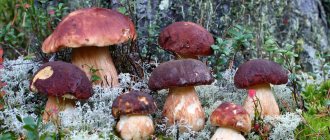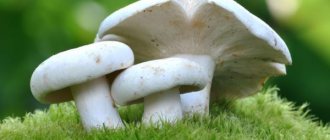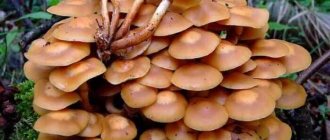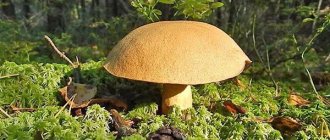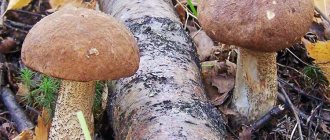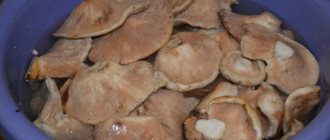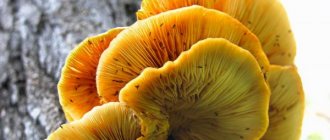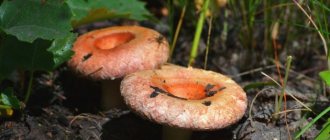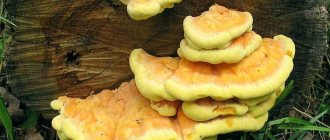Pan kings
Ryadovki is a large family of mushrooms, well known to Russian experts in quiet hunting. These forest inhabitants contain many substances useful to humans - manganese, zinc and copper, B vitamins, and also have the ability to destroy harmful bacteria. Connoisseurs of mushroom hunting prefer to pay special attention to the gray or purple rows. It is not at all difficult to prepare many appetizing and tasty dishes from these mushrooms, but it is important to know how and how long these mushrooms need to be boiled before further culinary use.
Gray row - description and photo
In September - October (or even in November, if the weather permits), many mushrooms with gray caps are sometimes found in our forests.
Gray row mushroom
They can grow alone. But other specimens are always found nearby. They can grow in “clumps”, literally piling up one on top of another. Can form “witch rings”.
Because of the gray color of their caps, these mushrooms are sometimes called “little mice.” The Russian scientific name is gray row. And since the surface of the caps, especially those of large fruiting bodies, is covered with a network of cracks, a kind of “hatching”, the mushroom is also called hatching.
This mushroom is not only completely edible, but also has a pleasant taste and aroma. And preparing a gray row is quite simple.
The gray row is not at all a close relative of the purple row, which I already wrote about. These mushrooms belong to different genera of the Ryadovkov family. The Latin names of mushrooms record this fact very accurately.
The violet row belongs to the genus Lepista, and in Latin it is called Lepista nuda. Gray rower is a representative of the genus Tricholoma, its Latin name is Tricholoma portentosum.
Gray row mycorrhiza forms with Scots pine, and grows in forests where this tree is found. True, I have not yet seen this mushroom in clean pine forests. But in coniferous-deciduous forests, where pine, spruce, birch and aspen grow, rows of sulfur can sometimes be collected quite a lot.
The row is gray (hatched) - the mushroom is quite large and dense. The diameter of the cap ranges from 5 to 15 cm, and the length of the rather thick stem reaches 10 cm or more. True, most of this long leg is usually hidden in moss or in the forest floor.
Gray row, otherwise called hatched row
The cap is initially bell-shaped and later becomes prostrate. There is no pronounced tubercle in the center of the cap. The top of the cap is covered with gray skin. This skin, especially on large mushrooms, cracks and creates a peculiar pattern (“hatching”).
Young gray rower
On the underside of the cap there is a spore-bearing layer (hymenophore) of thick and rather sparse white plates. In old mushrooms, the plates may turn yellow. The plates not only do not run down onto the leg - they do not even reach it a little.
Gray row plates
The leg is long, often curved, quite thick and dense. The base of the leg is slightly thickened. There is usually no cavity inside. It can only appear on an old fruiting body.
The leg of the gray row is long, but hidden in the moss
Gray row has a rather pleasant smell. They write about the smell of “fresh flour.” I don’t know, but it just seemed like a not very pronounced “mushroom aroma” to me. In any case, this mushroom does not have any rather pungent and unpleasant odor.
What mushrooms are similar to sulfur row?
Attentive readers of my blog probably know that I am not a supporter of the “fairy tale about false mushrooms” that is widespread on the Internet. They say that every edible mushroom has a very similar double - a “false mushroom”. And terribly poisonous! All he does is to watch and poison the mushroom picker! Such are the horrors...
Only all these horror films are, I repeat, fairy tales (or, to put it more firmly, one of the “mushroom myths”). All these “false whites”, “false boletuses”, etc., with which many Internet authors scare us.
You just need to look more carefully at the mushroom and remember its features. Nowadays, almost everyone has a camera on their phone. Take it off and look it up on the Internet. You will definitely find it.
One day was enough for me to get acquainted with the sulfur row. I found it in the forest - took a photo - looked it up in the guide - checked my guess on the Internet. There is a good group on Facebook called “What kind of mushroom?” Advanced users and competent experts will definitely give you advice. If only your photos were informative.
There are still mushrooms similar to the sulfur row in the forest. What unites them is not only the gray color of their hats. All of them belong to the genus Tricholoma. But each of these mushrooms has its own characteristic distinctive features.
The edible earthy row is smaller and thinner than the gray row. And her records are not white, but gray.
The inedible soap bark has a sharp, unpleasant odor, which is why it got its name. And her plates are greenish.
The inedible (or even slightly poisonous) pointed row is distinguished by a pronounced characteristic tubercle crowning the middle of the cap. The sulfur row does not have such a tubercle. And the taste of the pointed row is pungent and pungent.
Preliminary preparation
Rowers belong to the category of conditionally edible mushrooms and they must be soaked before use, but before the soaking process, freshly picked mushrooms must be prepared for further culinary processing.
- Fruiting bodies must be carefully sorted and cleaned of dirt and forest debris. The most stubborn stains can be scraped off with an old toothbrush or a knife blade. You need to carefully check the mushrooms for the presence of worms and rot and throw away specimens that are too damaged by them. If the area of damage is small, it can be easily removed with a knife.
- After cleaning the row, rinse thoroughly under running water.
Where and when do they grow?
In total, there are about a hundred types of rowing and almost half of them grow in our country, including the gray rowing. The favorite habitat of mushrooms is calcareous and sandy soils with the presence of moss; they prefer a temperate climate, which is not characterized by extreme heat and cold, so it can be found everywhere in the Northern and, partially, in the Southern Hemisphere. Most often, the organism forms symbiotic relationships with coniferous trees, especially pine, fir and spruce, but also deciduous trees such as birch, oak and beech.
Gray rows appear already in the spring, but, basically, fruiting begins at the end of summer and continues until the first cold weather in November. A cluster of mushrooms, or less often individual specimens, can be seen not only in forests and undergrowth, but also near human habitats, in parks and gardens.
A feature of mushroom mycelium is that it grows in entire colonies, which is why the mushroom gets its name. True, sometimes it grows not in rows, but in characteristic circles.
Soaking
Before further use, the rows must be soaked in water with added salt for up to 48 hours.
- The fruiting bodies are poured with cold water so that it completely covers them. It is necessary to press down the mushrooms with a weight so that they are exactly under the water level.
- It is recommended to add 10 grams to water. salt and 2 gr. citric acid per liter.
- The water needs to be changed every few hours.
- The soaking period, on average, lasts about 2 days.
Cooking time for row mushrooms
How long should you cook the rows until they are done so that the final result of the resulting dish is tasty?
It is worth saying that the cooking time for the rows will depend on what you will do with them in the future: fry, salt or pickle. Mycologists strongly recommend boiling the rows to avoid unpleasant moments, namely poisoning. You should not try raw rows; sometimes you can be poisoned by edible species.
Sometimes mushroom pickers collect conditionally edible species of rows - how to cook these fruiting bodies? Before starting the thermal process, you need to soak the mushrooms for 2 days, and during this time change the water several times. Many cooks use one simple method that allows them to determine how much rowing to cook. As soon as the mushrooms sink to the bottom of the pan during boiling, they are ready. Knowing the answer to the question: how long does it take to cook the rows, every housewife will be able to prepare real culinary masterpieces from the rows.
We offer several recipes showing how to properly cook rows before the following processes.
How to cook rows
Soaking almost completely removes bitterness and various substances that are unhealthy from the rows, but in order to reliably use these mushrooms for food, they must be boiled
Before salting
The rows can also be salted cold - without boiling, but then they need to be soaked for a very long time - up to 72 hours.
When salting hot, double boiling is used:
- Boil the mushrooms in salted water for 20 minutes and then rinse in a colander under running water.
- Boil the mushrooms again in boiling water for 20 minutes, adding salt and vinegar in the proportion of 1 tablespoon per liter of water.
- Next, dry the mushrooms in a colander and start pickling.
Before frying
It is not necessary to soak the rows for a long time before frying, but this procedure will still be required.
- Soak the fruit bodies in cold, clean water and then dry in a colander.
- Boil the rows in salted water (a third of a tablespoon of salt per liter of water) for 15 minutes, constantly skimming off the foam. Then dry the mushrooms in a colander. If you add vinegar to water - 1 tbsp. spoon per liter - this will prevent the mushrooms from darkening, which often happens in the case of rows.
- Boil the mushrooms again for 15 minutes, removing the foam, and then dry them in a colander, after which the rows can be fried.
Before freezing
Before freezing the rows, you don’t need to soak or cook them at all, but freeze them raw - this way the mushrooms are preserved in their most pristine form, and all these procedures can be performed with them after defrosting. The only negative is that raw mushrooms will take up much more space in the freezer.
If you decide to soak the rows before placing them in the freezer, then you need to do this for 3 hours.
When cooking, the rows sometimes begin to smell like rotten flour. To prevent this from happening, they can be boiled with the addition of a small onion, cut into several pieces and a couple of bay leaves. And adding a teaspoon of citric acid will prevent the mushrooms from darkening during cooking.
- Boil the mushrooms in salted water for 10 minutes, skimming off the foam. Then dry the mushrooms in a colander.
- Repeat the procedure two more times, and, before the freezing process, dry the rows in a colander.
Before marinating
Before pickling, the rows must be soaked for 5 hours.
- Boil the mushrooms for 15 minutes, constantly skimming off the foam, and then dry them in a colander.
- Repeat the procedure one more time.
- After drying, the rows can be pickled.
Before baking in the oven
Before this procedure, the rows must be soaked for at least 2 days.
- After boiling, boil the fruit bodies in salted water for 15 minutes, constantly skimming off the foam. Next, rinse the mushrooms under running water and dry in a colander.
- Repeat the procedure again.
- Sprinkle the rows with pepper and salt, mix, place on a greased baking sheet and bake in the oven at 180 degrees. within 30 minutes.
- Next, pack the product tightly into sterilized jars and close the lids, following the rules for safe home canning.
Advantages of sulfur rowing
What are the undoubted advantages of rowing with sulfur?
- The mushroom sometimes grows quite abundantly. And not alone. Having discovered a gray row, you will probably leave the forest not with an empty basket.
- The gray row is unique enough to be remembered and not to be confused with inedible or poisonous mushrooms.
- Gray row is a mushroom that grows in late autumn. Usually in the middle - end of October you will not find the usual summer mushrooms in the forest. But the rows - gray and purple - grow at this time, and quite abundantly. And they tolerate the first frosts well.
- The sulfur row has a very pleasant taste and aroma, especially when fried.
- The gray row can also be salted, pickled, or frozen in boiled form.
So the gray row (hatched) is a rather pleasant mushroom with undoubted advantages. Moreover, mycologist Mikhail Vishnevsky in his book “Medicinal Mushrooms” describes the gray row as a medicinal mushroom, which has a powerful antioxidant effect.
Of course, we do not prepare mushroom extracts at home. But it’s nice to think that just by eating fried mushrooms, you at the same time bring some benefit to your body!
Best regards, Alexander Silivanov
How to preserve boiled rows
It often happens that the mushrooms are cooked, but not all of them are used, and the forest gifts that remain unused must be preserved for future use.
Already boiled rows must be stored in the refrigerator at a temperature of 0 to +4 degrees. If you place forest gifts in enamel or glass containers, they can be stored in the refrigerator for 24 to 36 hours.
If you place the rows along with the decoction in a sterilized jar and tightly close it with a lid, then such a product can be stored for up to 7 days.
Recipes for popular dishes with boiled rows
The row makes a nutritious and tasty soup. The cooking process consists of the following steps:
- Pre-processed and soaked mushrooms are boiled until half cooked in clean salted water and drained in a colander.
- At the same time, a broth is prepared based on chicken, potatoes, cauliflower, beans or other vegetables.
- The washed mushrooms are finely chopped and fried in a small amount of vegetable oil until golden brown along with chopped onions and carrots. If desired, you can add a little granulated sugar to this frying so that the carrots can retain their bright orange color.
- The frying is added to the soup 5 minutes before the end of its preparation.
After pouring the soup into bowls, you can garnish it with fresh dill and thick sour cream. In addition, some chefs serve it in an edible plate of homemade bread, which you can enjoy at the end.
How to salt rows
To salt the rows, you must use wooden, enamel or glass containers. Do not use galvanized, copper, aluminum, plastic or ceramic containers.
Enameled and glassware should initially be thoroughly washed with soda and sterilized in the oven at a temperature of 200 degrees.
Wooden dishes must first be soaked in water for several days so that they become waterproof, and if the dishes have just been purchased, then they must be soaked for at least 2 weeks to remove all tannins, which can subsequently turn the mushrooms black.
After soaking, the wooden containers are scrubbed with a stiff brush and poured with a boiling solution of caustic soda (5 grams of soda per 1 liter of water). Now all potential harmful microorganisms from the walls of the dishes will be removed.
It is best to salt mushrooms when they are approximately the same size, so if possible, you need to sort them and salt small ones with small ones, and large ones with large ones.
How to distinguish an inedible mushroom from an inedible one?
There are many mushrooms similar to the gray row. Among several species there are poisonous gray rowers, so before collecting them, you should carefully study their similarities and differences.
The most similar to the gray row is the pointed row. It is inedible due to its bitter taste. She has exactly the same gray hat, which is also cracking at the edges. But in this mushroom, the center of the cap is a pointed, strongly protruding tubercle. It can be distinguished by both its pulp and its plates: the pointed one is grayish-white, and the gray one is yellowish-white. And the pointed row is thinner and smaller in size, and it does not grow in large clusters, like the gray edible one.
Tips for salting rows
- You should use regular table salt. Iodized or marine can cause the product to sour. Usually 50 g is required. salt per 1 kg. mushrooms
- Adding mustard increases the elasticity of the product and serves as an additional preservative.
- By increasing the proportion of garlic when pickling mushrooms, you increase the degree of spiciness of the finished product. Salted garlic from pickles can also be used as a separate appetizer.
- When filling the jar, you need to take into account the standard rules - the weight of the added liquid should be equal to 20% of the total weight of the mushrooms.
- Often mold appears on the lid of the pickling container. It must be removed immediately, and the lid and weight must be washed with saline solution (3 tablespoons of salt per 1 liter of water). You can prevent the formation of mold by sprinkling mustard powder on top of the workpiece.
- The shelf life of sealed homemade canned mushrooms, subject to storage rules, is 12 months.
- The opened jar should be kept in the refrigerator for no longer than a few days.
- A product made using the cold-salting method should be stored for no longer than 6 months.
- Homemade canned food should be stored in the refrigerator or cellar at a temperature of 0 to +8 degrees.
Baking rows in the oven
What can you cook from row mushrooms if you use the oven?
Try pampering your family with a delicious dish of mushrooms baked with pasta, and they will certainly thank you for such a tasty dish.
- 700 g of boiled rows;
- 200 g small vermicelli;
- 2 tbsp. l. breadcrumbs;
- 100 ml butter;
- 2 onions;
- Salt - to taste;
- 1 tsp. ground black pepper;
- 150 ml sour cream;
- 3 eggs;
- Dill and/or parsley.
- Cut the boiled rows into slices and fry in butter until golden brown.
- Add diced onion and continue frying for 10 minutes over low heat.
- Add all the spices and continue to simmer for 10 minutes.
- Boil the vermicelli until tender, strain and mix with mushrooms.
- Grease a baking sheet and sprinkle with breadcrumbs.
- Beat the sour cream with eggs, place the mushroom mixture on a baking sheet, and then pour in the resulting sour cream and egg mixture.
- Place in the oven preheated to 180°C and bake for approximately 30 to 40 minutes. When serving, garnish with chopped herbs.
This casserole can be given even to children over 10 years old; they will be delighted with the dish.
Cold salting of rows
Advantages of the cold salting method:
- The mushrooms turn out especially tasty and crispy.
- This method is convenient for immediately salting a large amount of forest products.
- With this method, you can add fruiting bodies to already salted milk mushrooms, which is very useful if you managed to collect another portion of mushrooms.
The relative disadvantage of this method is the long duration of the salting process and the fact that cold salted products are more difficult to digest for some stomachs.
For cold salting you will need:
- Rows – 10 kg.
- Salt – 500 gr., rock, coarsely ground.
- Dill – 20 inflorescences, with seeds.
- Black peppercorns – 40 gr.
- Blackcurrant, horseradish and cherry leaves - 30 pieces each.
Salting:
- After preliminary preparation of the mushrooms and the container for pickling, place horseradish, cherry and currant leaves with dill inflorescences on the bottom of the container.
- Place a layer of mushrooms, about 7 cm thick, legs up, sprinkle salt and a mixture of spices on top. Next, add a layer of mushrooms again and repeat until the container is full.
- Sprinkle the top layer of the product with salt and spices especially carefully.
- Next, gauze is laid out on top, folded in several layers, a lid is placed on it and a load is placed. A large flat plate can serve well as a lid, and a three-liter jar of water can be conveniently used as a weight.
- The container with the product should be placed in a dark and cool place for a period of 60 days. All this time you need to monitor the condition of the workpiece. Mushrooms under the load will release juice, which should completely cover them. If the amount of juice is not enough, you can increase the weight of the load, or add saline solution (30 grams per liter of water) into the container.
- During the first weeks of pickling, it is permissible to add new mushrooms to the container if the pickling conditions allow it.
- If the top layer becomes moldy, it must be removed and the lid and weight washed with saline solution.
- When the salting process is over, the product should be transferred to glass jars and stored in the refrigerator for no more than 6 months.
Brief description of some similar species
As noted above, among the rows there can be inedible, edible and poisonous (weakly poisonous) mushrooms:
- the earthy row (semi-edible), characterized by its smaller size, sparse plates and fibrous scaly surface of the cap;
- different row (semi-edible), having an unpleasant odor and a green, brown or white stem;
- soap row (inedible), colored more evenly and having a strong smell of laundry soap;
- the row is pointed (weakly poisonous), distinguished by a thin ashy cap, with a noticeable conical tubercle in the middle, as well as a burning pulp to taste;
- tiger row (large and very poisonous), distinguished by a gray cap covered with black spotted small scales and flesh, which turns pink when touched and cut, especially at the stem.

